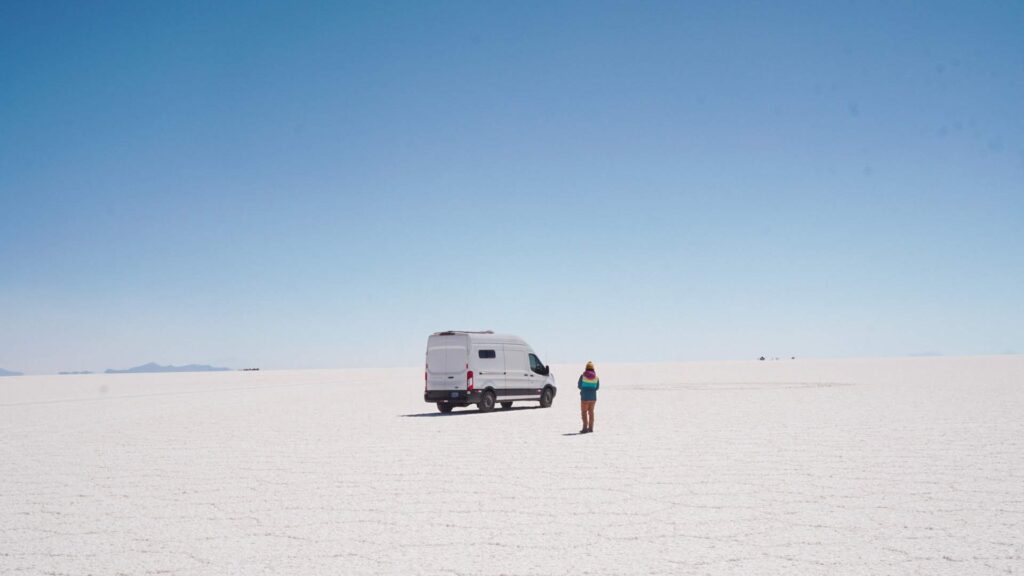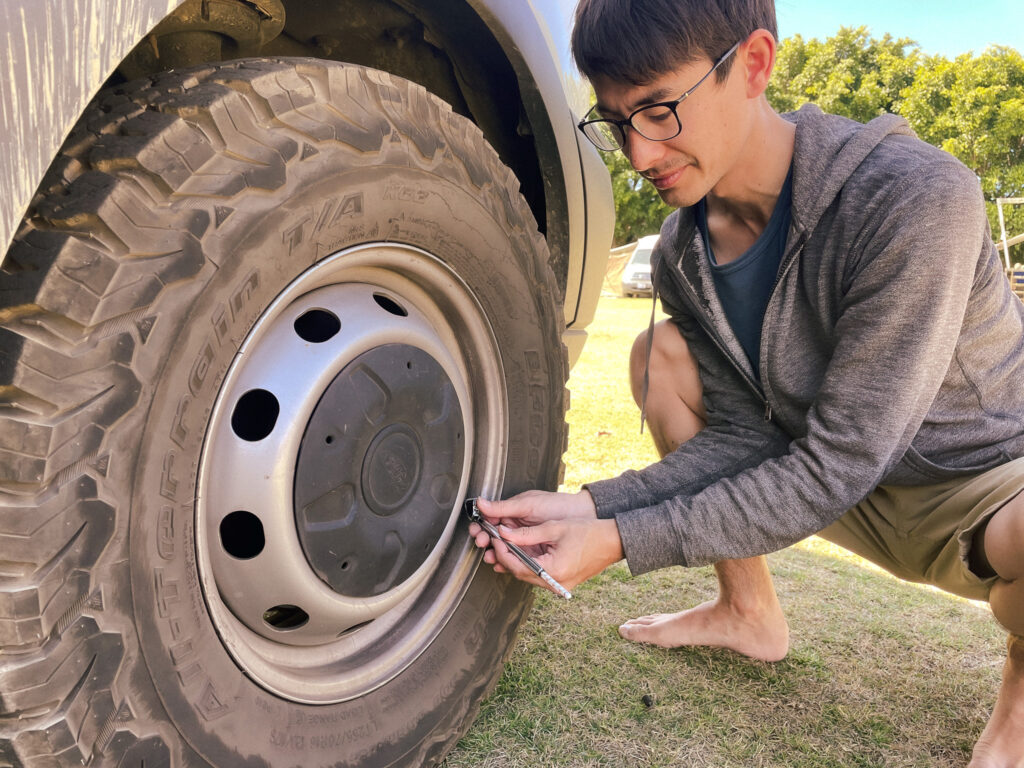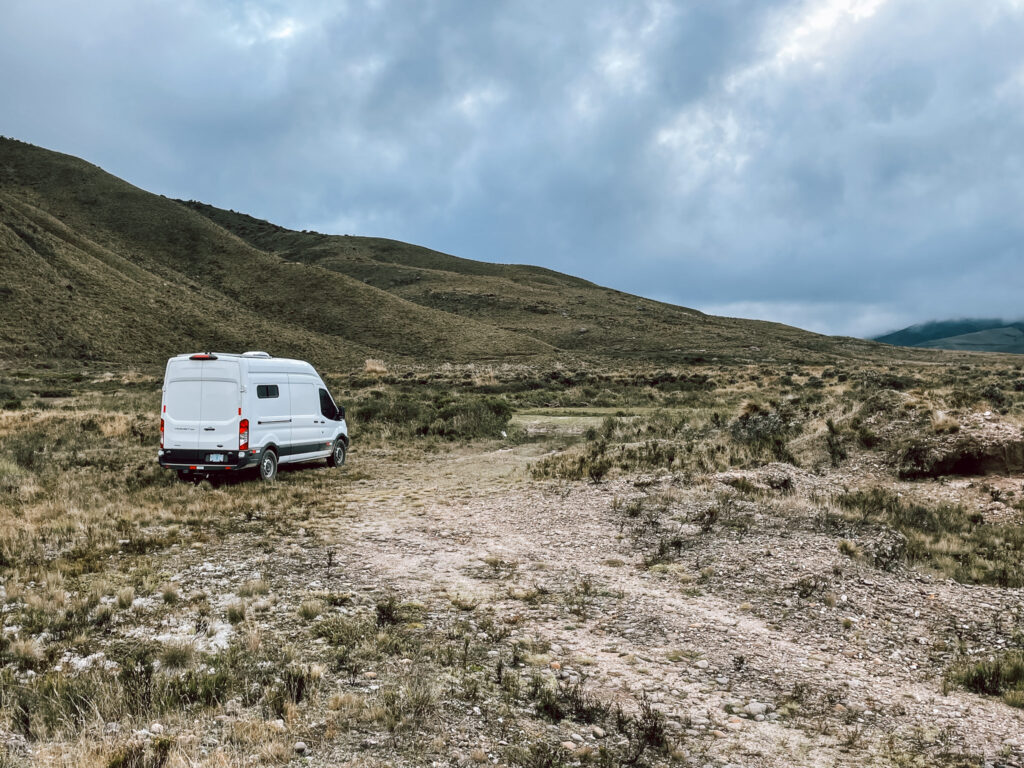Getting out into nature is one of the best aspects of traveling in an RV. But arriving at many of the best spots means getting off the safe, asphalt road and driving on dirt, rocky, and sandy paths. This is simple enough if your RV is equipped with four-wheel drive (4WD), but what if you only have a 2WD camper?
Can you still drive offroad with a 2WD vehicle? And the answer is: Yes, you can!
We own a 2WD Ford Transit camper and have driven our vehicle from Canada to Argentina through some fairly difficult terrain. And yes, we’ve gotten stuck a few times. But much more often than not, our vehicle successfully handled the offroad challenges that we’ve met.
So in this post, we want to go over some of the most important tips and tricks we use when navigating off road with a 2WD camper van.

Get The Right Products
We’re fairly minimalist, but even we understand that it’s important to stock up on the right products to give your 2WD camper as much help as possible before heading off road. Below are our top 5 recommendations:
All-Terrain Tires
Purchasing adequate all-terrain (AT) tires is the #1 thing you can do to help you succeed when driving on challenging paths. AT tires increase your camper’s traction to the road and help propel your vehicle forward. These tires also have thicker sidewalls, which makes them more resilient to rock punctures. These BFGoodrich KO2 tires, which is what we use, are even rated for acceleration in moderate snow conditions. Learn more about All-Terrain Tires.
Upgrade Suspension: Leaf Springs & Sumosprings
When driving off-road, your RV will sway a lot! This is common since dirt roads are rarely even. However, you can reduce sway by improving your vehicle’s suspension, which includes upgrading the camper’s leaf springs to better support the weight of the vehicle. For a more economical solution, consider getting SumoSprings, which you can easily install yourself. Check out our post to learn more about the wonders of SumoSprings.
Recovery (Traction) Boards
Eventually, getting stuck is inevitable with a 2WD camper. It’s already happened to us four times! That’s why picking up a pair of recovery boards is essential. When your tires can’t grip the ground, you place the recovery boards under the tires to give them the traction they need to push your vehicle out of the jam.
Recovery Strap & D-Ring
And when you get stuck and you’re completely unable to get out by yourself, it’s a good idea to carry a recovery strap and D-ring to help others help you get out. This works assuming you have a hitch attached to your vehicle. If you can flag down another vehicle, preferably a pickup truck, you can attach the D-ring to your hitch and attach the snatch strap to both vehicles. Then, it’s a simple tug from a kind stranger to get your RV back up and running.
Air Compressor
Deflating your tires is an important aspect to off-roading. We talk more about this in the next section, but you will need an air compressor to reinflate your tires when you get back to asphalt roads.
Learn To Deflate Your Tires

Did you know that you should be adjusting your tire’s air pressure depending on if you’re driving on asphalt or dirt roads? In fact, the worse the road condition, the less air pressure (PSI) that should be in your tires.
High tire pressure is good for driving on highways and smooth, concrete roads. They also help to maximize your vehicle’s fuel economy. But tires with high pressure don’t do well when off-roading. Not only will you have a bumpier ride (you’ll feel every rock and divot), but rigid tires also have less traction with the road, which increases your chances of getting stuck in sand and mud.
Therefore, it’s a good idea to release air from your tires if you intend to take your RV off-road. Reducing the PSI in the tires helps improve their road traction and gives you a smoother ride. This is especially helpful when driving on rough, corrugated roads.
As an example, when driving on highways, we keep our tires at around 65PSI. But when going off-road, we will deflate our tires down to somewhere between 30-45PSI, depending on the road condition.
Understand Your Vehicle’s Clearance
When heading off-road, you’ll encounter lots of rocks, roots, and other objects jutting from the ground. Most of these protrusions aren’t serious and you can simply drive over them. But some of these objects can be quite tall and, if you’re not careful, they can damage the underbody of your vehicle.
Typically, it is your rear shocks and rear differential that hang most closely to the ground and are the most at risk to being hit by objects on the road.
Therefore, it’s important to know how many inches above the road your rear shocks and differential are. That way, you’ll know which road protrusions you can safely drive over, and which you should probably drive around to avoid. You can do this with a simple measuring tape and a willingness to get under your RV’s chassis to measure!
Stop & Asses The Road Ahead
If you’re driving and the road ahead is starting to look iffy, the best thing you can do is to stop, turn off the engine, get out, and continue onwards on foot to assess the quality of the path.
Specifically, you will want to look for:
- Unusually sandy or muddy sections,
- Unusually steep or uneven sections,
- Major rock and root protrusions on the path,
When looking at the path ahead, try to envision a path where all four wheels of your vehicle can safely drive on to help get you across the terrain. It’s good to have a rough calculation in your head of the distance between your left and right tires, and front and back tires.
Nobody likes to have to ‘waste time’ to get out and evaluate the road ahead. But each of the four times that we’ve gotten stuck was because we underestimated the difficulty of the road and overestimated our vehicle’s capabilities…
…Which leads us to our last point…
Understand The Limitations Of Your 2WD RV

We love our 2WD Ford Transit. From Canada to Argentina, it’s taken us ‘almost’ everywhere we’ve ever wanted.
But the key word here is “almost”.
We understand that our camper van isn’t a 4WD juggernaut capable of driving on deep sandy beaches and muddy ruts. Nothing can replace the power and versatility of all four tires being powered by a vehicle’s engine.
And that’s why it’s critical to understand the limitations of your own camper.
- How much sand is too much?
- How much mud is too much?
- How steep of a road is too steep?
These are questions you can only really answer the more off-road driving experience you get. But if you start on easy dirt paths, you can work your way up to more complex terrain as you gain more experience. Eventually, you might get your rig stuck. But though it might feel like it at the time, it’s not the end of the world. You will get unstuck and will have learned a little more about the limitations of your 2WD camper. And next time, you’ll be that much more careful and wiser.
Conclusion
We hope this post helped give you confidence to start taking your camper off-road to experience the best that nature has to offer. There are so many beautiful places in this country that can absolutely be reached with just a 2WD motorhome.
But it helps to be prepared before you go and to drive slowly once the terrain starts to get challenging. And if you’re careful, we’re confident that you can get to where you want to go and park in that amazingly stunning, IG-worthy spot.
If you have any questions, please feel free to reach out by sending us an email at [email protected]
Happy travels!
How To Contact Us
For more campervan living & building tips, check out our blog: www.asobolife.com.
Or for more on our current Pan-American road trip to Argentina visit us on Instagram: @asobo-life
Want to learn more about Off-Road RVing? Check our other blogs:

